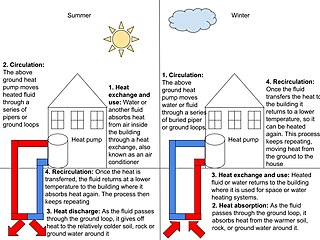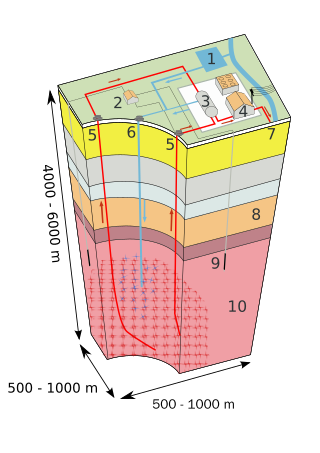
Geothermal energy is thermal energy extracted from the Earth's crust. It combines energy from the formation of the planet and from radioactive decay. Geothermal energy has been exploited as a source of heat and/or electric power for millennia.

Geothermal heating is the direct use of geothermal energy for some heating applications. Humans have taken advantage of geothermal heat this way since the Paleolithic era. Approximately seventy countries made direct use of a total of 270 PJ of geothermal heating in 2004. As of 2007, 28 GW of geothermal heating capacity is installed around the world, satisfying 0.07% of global primary energy consumption. Thermal efficiency is high since no energy conversion is needed, but capacity factors tend to be low since the heat is mostly needed in the winter.

The electricity sector in Canada has played a significant role in the economic and political life of the country since the late 19th century. The sector is organized along provincial and territorial lines. In a majority of provinces, large government-owned integrated public utilities play a leading role in the generation, transmission, and distribution of electricity. Ontario and Alberta have created electricity markets in the last decade to increase investment and competition in this sector of the economy.

The potential for exploiting geothermal energy in the United Kingdom on a commercial basis was initially examined by the Department of Energy in the wake of the 1973 oil crisis. Several regions of the country were identified, but interest in developing them was lost as petroleum prices fell. Although the UK is not actively volcanic, a large heat resource is potentially available via shallow geothermal ground source heat pumps, shallow aquifers and deep saline aquifers in the mesozoic basins of the UK. Geothermal energy is plentiful beneath the UK, although it is not readily accessible currently except in specific locations.

Canada has access to all main sources of energy including oil and gas, coal, hydropower, biomass, solar, geothermal, wind, marine and nuclear. It is the world's second largest producer of uranium, third largest producer of hydro-electricity, fourth largest natural gas producer, and the fifth largest producer of crude oil. In 2006, only Russia, the People's Republic of China, the United States and Saudi Arabia produce more total energy than Canada.

Geothermal energy was first used for electric power production in the United States in 1960. The Geysers in Sonoma and Lake counties, California was developed into the largest geothermal steam electrical plant in the world, at 1,517 megawatts. Other geothermal steam fields operate in the western US and Alaska.

An enhanced geothermal system (EGS) generates geothermal electricity without natural convective hydrothermal resources. Traditionally, geothermal power systems operated only where naturally occurring heat, water, and rock permeability are sufficient to allow energy extraction. However, most geothermal energy within reach of conventional techniques is in dry and impermeable rock. EGS technologies expand the availability of geothermal resources through stimulation methods, such as 'hydraulic stimulation'.

Geothermal power is electrical power generated from geothermal energy. Technologies in use include dry steam power stations, flash steam power stations and binary cycle power stations. Geothermal electricity generation is currently used in 26 countries, while geothermal heating is in use in 70 countries.
Through the 1996 Electric Utilities Act the Alberta's deregulated electricity market began.

Historically, the main applications of solar energy technologies in Canada have been non-electric active solar system applications for space heating, water heating and drying crops and lumber. In 2001, there were more than 12,000 residential solar water heating systems and 300 commercial/ industrial solar hot water systems in use. These systems presently comprise a small fraction of Canada's energy use, but some government studies suggest they could make up as much as five percent of the country's energy needs by the year 2025.
According to the International Hydropower Association, Canada is the fourth largest producer of hydroelectricity in the world in 2021 after the United States, Brazil, and China. In 2019, Canada produced 632.2 TWh of electricity with 60% of energy coming from Hydroelectric and Tidal Energy Sources).

Renewable energy in Canada represented 17.3% of the Total Energy Supply (TES) in 2020, following natural gas at 39.1% and oil at 32.7% of the TES.
Geothermal energy is the second most used form of renewable energy in Russia but represents less than 1% of the total energy production. The first geothermal power plant in Russia, which was the first Binary cycle power station in the world, was built at Pauzhetka, Kamchatka, in 1966, with a capacity of 5 MW. The total geothermal installed capacity is 81.9 MW, with 50 MW coming from a plant at Verkhne-Mutnovsky.Two other plants were built on the Kamchatka Peninsula in 1999 and 2002. Two smaller additional plants were installed on the islands of Kunashir and Iturup in 2007. Most geothermal resources are currently used for heating settlements in the North Caucasus and Kamchatka. Half of the geothermal production is used to heat homes and industrial buildings, one third is used to heat greenhouses and 13% is used for industrial processes.

Geothermal exploration is the exploration of the subsurface in search of viable active geothermal regions with the goal of building a geothermal power plant, where hot fluids drive turbines to create electricity. Exploration methods include a broad range of disciplines including geology, geophysics, geochemistry and engineering.

Most of Kenya's electricity is generated by renewable energy sources. Access to reliable, affordable, and sustainable energy is one of the 17 main goals of the United Nations’ Sustainable Development Goals. Development of the energy sector is also critical to help Kenya achieve the goals in Kenya Vision 2030 to become a newly industrializing, middle-income country. With an installed power capacity of 2,819 MW, Kenya currently generates 826 MW hydroelectric power, 828 geothermal power, 749 MW thermal power, 331 MW wind power, and the rest from solar and biomass sources. Kenya is the largest geothermal energy producer in Africa and also has the largest wind farm on the continent. In March 2011, Kenya opened Africa's first carbon exchange to promote investments in renewable energy projects. Kenya has also been selected as a pilot country under the Scaling-Up Renewable Energy Programmes in Low Income Countries Programme to increase deployment of renewable energy solutions in low-income countries. Despite significant strides in renewable energy development, about a quarter of the Kenyan population still lacks access to electricity, necessitating policy changes to diversify the energy generation mix and promote public-private partnerships for financing renewable energy projects.

Renewable energy in Armenia ranges from geothermal, hydroelectric, solar and wind energy in Armenia.

The Puna Geothermal Venture (PGV) is a geothermal energy power plant on the island of Hawaii, the largest island in the state of Hawaii. The plant was shut down shortly after the start of the May 2018 lower Puna eruption, and resumed power generation in November 2020. The eruption had caused lava to flow over a PGV power substation, a warehouse and at least three geothermal wells that had been preventatively quenched and capped when lava fountains erupted nearby, eventually also cutting off road access.
Geothermal power in Ukraine has substantial potential for further development. There is about 6.96 MWt of geothermal heating of communal buildings and baths in Ukraine with this continuing in an upward trend following a lack of reported geothermal data from 2005-2020. Commercial use of heat pumps as well as balneological purposes can be directly linked to the growth of this number. As of 2023 there is 0 MW of geothermal electricity generation in Ukraine. Despite this, there has been initiative to examine the prospective capabilities of this region and results have demonstrated that there are locations proven to be adequate for further development.

Solar augmented geothermal energy (SAGE) is an advanced method of geothermal energy that creates a synthetic geothermal storage resource by heating a natural brine with solar energy and adding enough heat when the sun shines to generate power 24 hours a day. The earth is given enough energy in one hour to provide all electrical needs for a year. Available energy is not the issue, but energy storage is the problem and SAGE creates effective storage and electrical power delivery on demand. This technology is especially effective for geothermal wells that have demonstrated inconsistent heat or idle oil or gas fields that have demonstrated the proper geology and have an abundance of solar.
Eavor Technologies Inc. is a global geothermal technology company headquartered in Calgary, Alberta. The firm was founded in 2017 with the goal of producing a scalable form of baseload, dispatchable energy.


















